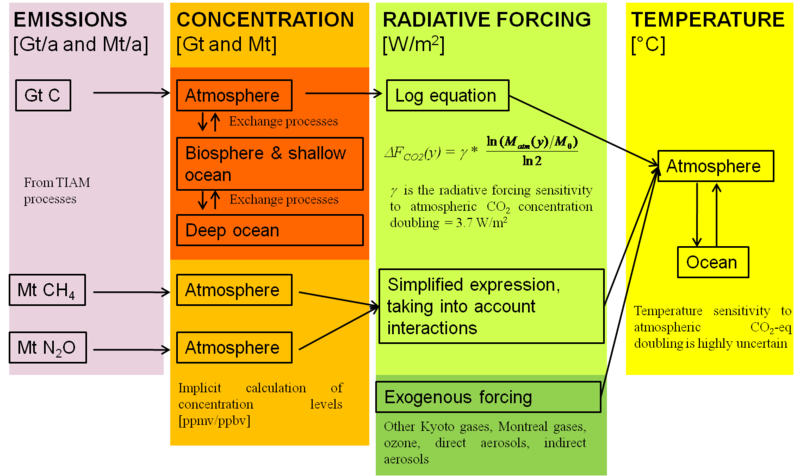Climate - TIAM-UCL
| Corresponding documentation | |
|---|---|
| Previous versions | |
| Model information | |
| Model link | |
| Institution | University College London (UCL), UK, https://www.ucl.ac.uk. |
| Solution concept | Partial equilibrium (price elastic demand) |
| Solution method | Linear optimisation |
| Anticipation | Perfect Foresight
(Stochastic and myopic runs are also possible) |
The climate module is a simplification of the climate system incorporating emissions of three major greenhouse gases (carbon dioxide, methane and nitrous oxide) to calculate radiative forcing and temperature changes. The results of the climate system (temperature change) can been linked to simplified damage functions to calculate future costs brought by climate change. We have extracted damage functions from the integrated assessment model PAGE09 (Hope 2011). After a recalibration of the climate module of TIAM-UCL using the latest version of the MAGICC climate model (Meinshausen et al. 2011), we have matched data from the 8 regions within PAGE onto the 16 regions included within TIAM-UCL to produce the climate module
The climate module uses emissions that are endogenously calculated in TIAM as an input. These are carbon dioxide (CO2), methane (CH4) and nitrous oxide (N20). Successively, it calculates changes in the concentration of CO2, CH4 and N2O, change in radiative forcing over pre-industrial times from all three gases plus an exogenously defined additional forcing and finally the temperature change over pre-industrial times for the atmosphere and the deep ocean. Figure 5.1 gives a graphical overview of the modules structure.
The underlying mathematical structure of the module is based on a linear recursive approach from Nordhaus and Boyer (1999). This is a well-documented, albeit simple approach, which gives a good approximation of more complex climate models (Loulou et al. 2010, p. 3).
Instead of converting non-CO2 greenhouse gases into CO2-equivalents and calculating concentrations and radiative forcing on this basis, the module models the life cycle of each endogenous emission separately.
Figure 5.1: Illustration of the TIAM climate module
<figure id="fig:climate_module.png">
